There are all kinds of toys and fun gadgets around the house for most people that might work or be broken, but either way most people wouldn’t know how do they work inside. For example take this solar powered Tibetan prayer wheel. There are many of these out there, and found one at home lying around as well. It didn’t seem to work, and thought why not take apart to take a look?

The inside of this Tibetan prayer wheels is pretty straightforward: taking off the bottom cover out come two ballast stones, and drivebox with a solar panel hanging off it. The drivebox is connected to the prayer wheel outside via a rectangular shaft to turn it.
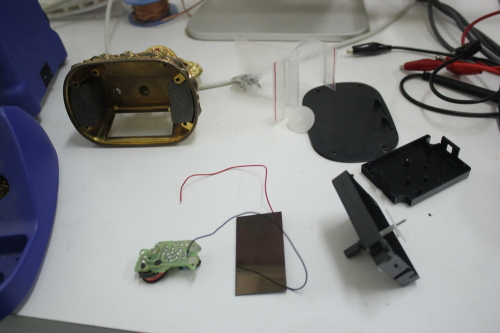
The drivebox contains an electronic circuit and a couple of cogwheels to turn the DC solar power into motion somehow. Originally the solar panel was not detached from the circuit board as it seems above, just after messing around with it for a while it came off…
Electronics
The circuit has only a handful of components and they looked reasonably intact (some surface corrosion on the capacitors and lot of grime on the transistors, but nothing that seems to be a showstopper). The round black thing on the right is a spool of thin, enamel coated wires – a custom inductor. The wires were spun in both directions, so it is actually two inductors intertwined. The transistors are C945 according to their marking (or 2SC945 in it’s full name, as I’ve been told). The two lines leaving the photo to the left connect to the solar panel.
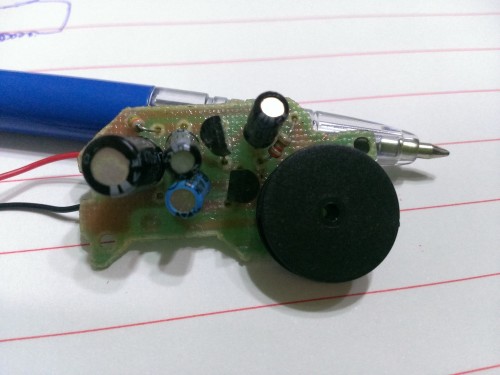
The bottom of the circuit. From here it can be reverse engineered to see how does it actually work. The enamel coated wires were freaky to have a lot of extra length after their soldering point and been all over the circuit. Probably that would be good to cut short to make sure they don’t cause any shorts in the future… The resistors were desoldered so I can check their component value, the capacitor values were read off their housing, the inductor I didn’t touch this time, so their value is an outstanding question…
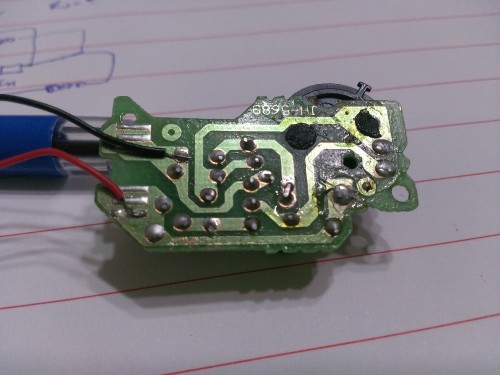
To figure out what the circuit does, it helps to transcribe the diagram into schematic well. Then I messed up the legs of the transistors in the up-down flipping multiple times, so the circuit came out all wrong. Fortunately JohnnyThree at Reddit AskElectronics helped (may he be blessed with lot of karma!:), not just to correctly transcribe the circuit but arrange the components so that it shows what the circuit really is: a variation on an astable multivibrator.
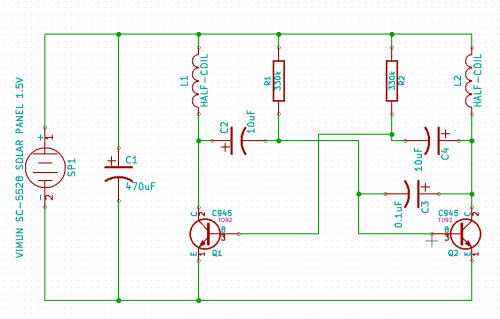
I fixed up the circuit in KiCAD (good learning experience as well, and go open source!). The difference between the regular astable multivibrator and this circuit is C3 capacitor between the base and collector of Q2 (according to JohnnyThree it’s to curb RF interference), and using inductors L1 and L2 instead of pure resistors.
Here are some additional resources if anyone’s interested:
Been checking some of the components separately as well when trying to figure out what was going wrong. The solar panel has VIMUN SC-5528 marking on it, which would make it a 1.5V poor light type amorphous silicon solar cell. This would make a lot of sense for home electronics, poor light is basically every light. When using my smartphone’s flash as a light, I could drive it up to 2.9V output at full power, but normally was much less.
Since the solar panel’s connections came off the board after a while, I resoldered them, and could measure with a multimeter that the circuit does something. When connected, the voltage across solar panel maxed out around 1.VV, and the voltage across either of the inductors seemed to be oscillating between 0.3V and 1.0V with a period of about 5s. Not sure if this is any useful, just noted.
When I’ve put the wheel with the magnets attached back in place over the coil, it was moving a bit back and forth with the 5s period. I thought maybe the device is back to normal after reattaching the solar panel and time to reassemble.
Reassembly
It was time to check out whether the setup was actually working and put everything back together. The wheels were pretty hard to test when not held at their place by the drivebox’s top.
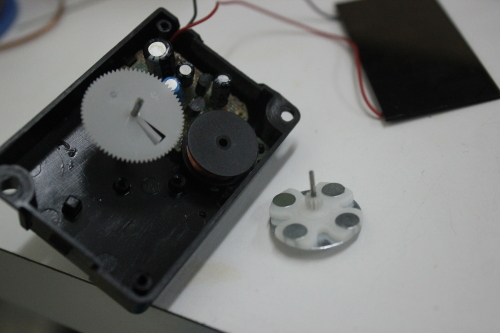
Before I’ve put the cogwheels back to the box, I’ve counted their gear ratios. The magnetic wheel has 10 teeth, the middle wheel has 70 / 12 teeth (in / out), and the final has 70 teeth again. That would mean a (70/10) × (70/12) = 7 × 5 = 35 gear ratio, I guess. The teeth on one wheel seemed not symmetric which ends up forcing the prayer wheel to only turn in one direction.
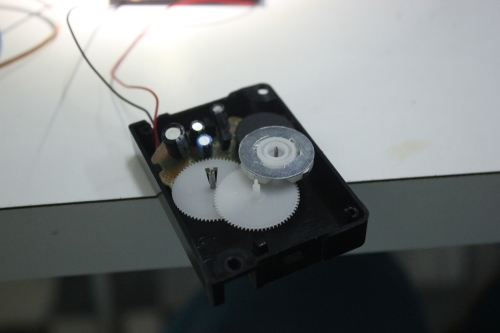
After putting the box back together, I’ve tried illuminating the solar panel with the flashlight again and see what happens. With a little initial turn the square drive shaft (is that what the thing is called, by the way?) it did start to rotate by itself pretty well! We are on the right track.
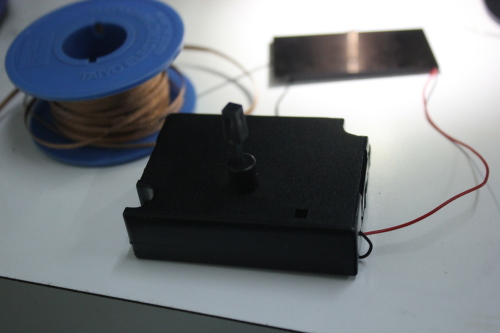
The biggest difficulty putting the parts back into the box was keeping the ballast stones from dropping on the solar panel and crashing it. A little careful handling and everything’s back in place.
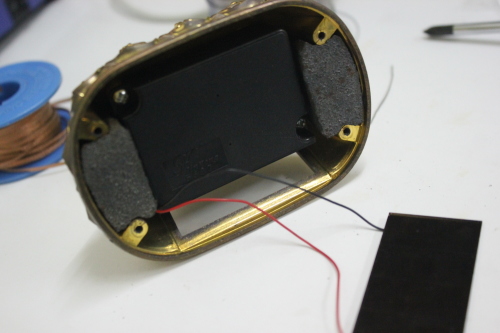
Finally I could test the whole assembly. Looks like the essential ingredients are sufficient light and an initial push. Not sure if the need for the initial push is intended or just a side-effect, but it actually mimics very well the existing physical Tibetan prayer wheels where one has to set them in motion, and the intention does count for the religious purposes. Though as a note, if the light is strong enough (full blast flashlight from up close), the wheel does start by itself and goes into pretty fast spin!
The prayer wheel part of the assembly has a lot more inertia than the driveshaft on its own, and this it the wheel turns slower than I’ve seen in the earlier test, and stops much quicker when the light is cut off.
In the video I test the wheel out, kickstarting it, blocking the light to see if it is really operating from the solar panel or just the initial kick keep it moving…. So far so good!
Future
A couple of things I can think of as future work with this gadget:
- Simulate the circuit in SPICE to understand the effect of the extra capacitor and the inductors
- Figure out whether it can it be fixed up to use less light? At the moment it’s not that easy to find a place around the house with sufficient natural light to make it work.
- Figure out if the friction on the wheels be reduced to make them turn easier / longer?
- What else could I hack this circuit to do?
And then again, what other gadget to take apart next time?
6 replies on “Solar powered Tibetan prayer wheel circuit”
Hi,i have a different issue with mine..first it stopped revolving days back for me..i thought its due to some jerk or something..however i opened up the inside of that black box..i found the coil connections are all broken at the back side of the chip,mine is JH5687B .. :( can u help where i can find a diagram or how i can reattach them properly..? thank u
nice! I chanced upon this looking for your football device (I forget exactly what it did… Can we resurrect it for the Euro 2016?) (was thinking of watching France-Ireland on the big screen at the hackerspace this evening haha)… Our household also has a broken solar-powered religious device, a waving/rocking money tree. No one seems to mind that it stopped rocking, and I couldn’t see anything obviously wrong with it last time I checked, but this will maybe give me courage to disassemble it when no one is looking
Pretty interesting post. Thanks for sharing. Did you take a look inside the prayer wheel if the mantra roll is properly done when you were examining its circuits?
Hi, I cannot say I did. Didn’t seem like there was anything inside the wheel, or are you expecting something? I think it’s only on the outside.
Oh. It’s just that I remember buying a small handheld prayer wheel, and the mantra roll inside was just a small piece of folded up paper so I wondered how’s the mantra roll inside a solar powered one. Maybe you should give yours a look? Here are some links to that might help you regarding prayer wheels:
fpmt.org/media/resources/microfilm-for-stupas-and-prayer-wheels/how-to-fill-a-prayer-wheel/
https://www.magiedubouddha.com/p_tib-prayer-wheels.php
[…] Instructions here. […]